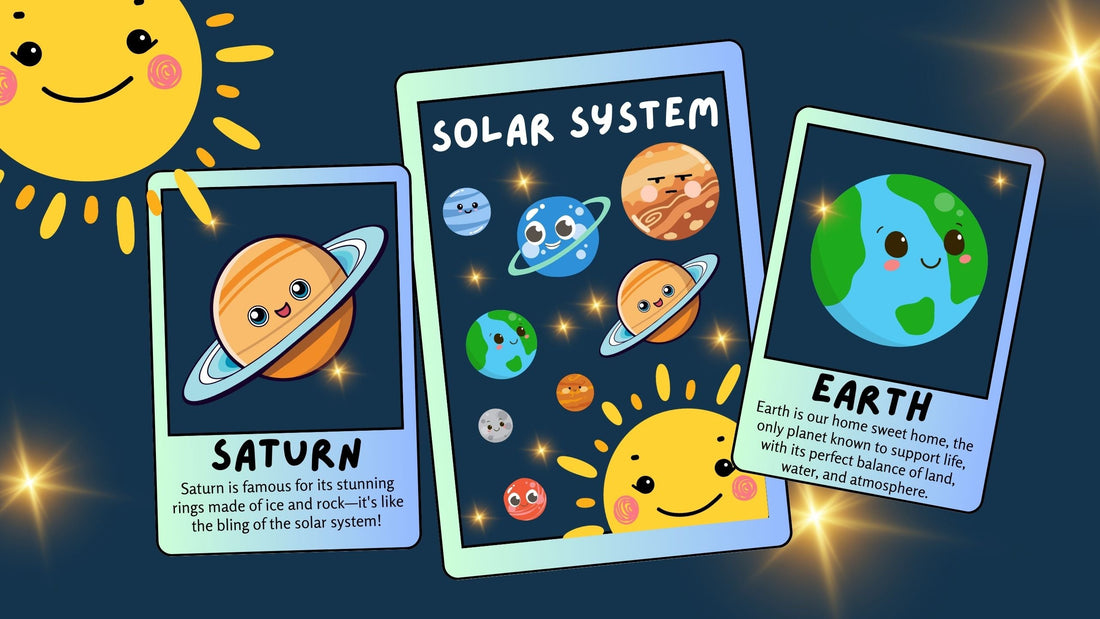Are you ready to dive into interstellar adventure without even leaving your seat? Whether you're a teacher looking to inspire young minds, a parent eager to educate your child about the cosmos, or simply a science lover with a curiosity that knows no bounds, we've got something special for you. Today, we’re diving into the wonders of our solar system with our incredible planet flashcards! ✨
Why Planet Flashcards?
Before we take off, let's talk about why these flashcards are so amazing. Think of them as your personal tour guide through the vastness of space. They provide bite-sized, fascinating facts about each planet in our solar system. Perfect for classrooms, science camps, or just a fun evening at home with family and friends!
Flashcards make learning interactive and engaging. Remember those thrilling moments when you'd flip a card and discover something new? That's exactly what we're aiming for—sparking joy and curiosity in every flip! 💡
Meet the Planets: Our Celestial Neighbors
Mercury: The Speedy Messenger
First stop: Mercury! Imagine standing on this small but mighty planet closest to the Sun. Mercury is like that friend who’s always first to arrive at the party—it zips around the Sun faster than any other planet! Did you know it takes just 88 Earth days for Mercury to complete one orbit? That’s less than three months!
Despite its speedy nature, life on Mercury would be quite extreme. With temperatures soaring up to 800°F during the day and plummeting to -290°F at night, it’s not exactly vacation-friendly. But isn't it fascinating how this little planet endures such drastic conditions?
Venus: The Fiery Twin
Next up is Venus, often called Earth's twin because of their similar size and structure. But don’t let appearances fool you—Venus is like Earth’s fiery sibling with a personality all its own. Its thick atmosphere traps heat in a runaway greenhouse effect, making it hotter than Mercury despite being farther from the Sun.
Imagine walking through an inferno where surface temperatures reach 900°F! And those clouds? They’re made of sulfuric acid! Venus might sound hostile, but its dramatic environment teaches us valuable lessons about climate change.
Earth: Our Blue Oasis
Ah, sweet Earth—our home and oasis in space! This vibrant blue planet teems with life thanks to its perfect distance from the Sun and its protective atmosphere. We have liquid water (the key ingredient for life), diverse ecosystems, and breathtaking landscapes from towering mountains to deep oceans.
What makes Earth truly special is its ability to support such an incredible variety of life forms. It’s like living on a masterpiece canvas painted by nature itself. Let’s cherish and protect this unique gem we call home.
Mars: The Red Frontier
Ready for an adventure on Mars? Known as the Red Planet due to its iron oxide-rich soil giving it a rusty hue, Mars has captured human imagination for centuries. With its massive volcanoes like Olympus Mons and deep canyons like Valles Marineris, Mars offers landscapes that rival any sci-fi movie set.
Mars also holds secrets beneath its surface—scientists believe there may be water ice hiding underground! Could this mean future human colonies on Mars? Only time (and exploration) will tell!
Jupiter: The Giant Guardian
Hold onto your hats because here comes Jupiter—the king of planets! As the largest planet in our solar system, Jupiter is a gas giant with swirling storms larger than Earth itself. The Great Red Spot is one such storm that has raged for centuries!
Jupiter's immense gravity acts like a cosmic shield, protecting inner planets from potential asteroid impacts. It’s like having a giant guardian watching over us—a comforting thought as we gaze up at the night sky.
Saturn: The Ringed Marvel
Saturn’s rings are arguably one of the most stunning sights in our solar system. Composed of ice particles, rocky debris, and dust, these rings create a mesmerizing halo around the gas giant. Have you ever wondered what it would be like to float among those rings?
Apart from its beauty, Saturn boasts over 80 moons—including Titan with its thick atmosphere and mysterious lakes of methane! Saturn reminds us that there's so much more to explore beyond what meets the eye.
Uranus: The Tilted Enigma
Uranus stands out with its unusual tilt—rotating on its side compared to other planets! This icy gas giant has faint rings and 27 known moons orbiting it in harmony. Imagine seasons lasting over 20 years due to this unique tilt!
Uranus' serene blue color comes from methane in its atmosphere absorbing red light while reflecting blue light back into space—a tranquil yet enigmatic world waiting for discovery.
Neptune: The Windy Wonder
Last but certainly not least is Neptune—the farthest planet from the Sun and another gas giant filled with mysteries. Known for supersonic winds reaching speeds up to 1,200 mph (faster than sound!), Neptune showcases dynamic weather patterns unlike any other.
Its deep blue color adds an air of mystique as we ponder what lies beneath those turbulent clouds. Triton—Neptune's largest moon—even orbits backward compared to other moons in our solar system!
Bringing It All Together 🌌
Exploring our solar system through these planet flashcards opens up endless opportunities for learning and fun! Whether you're planning educational activities at school events or sparking curiosity during family game nights at home.
So why wait? Grab your set today and dive on this celestial journey together! Let's keep exploring!
If you've enjoyed this cosmic tour or have any questions about our flashcards—or anything else related—feel free to reach out via email at support@istiloprints.com or sign up below for more info, exclusive deals and more fun stuff! We're always here excitedly sharing knowledge.








